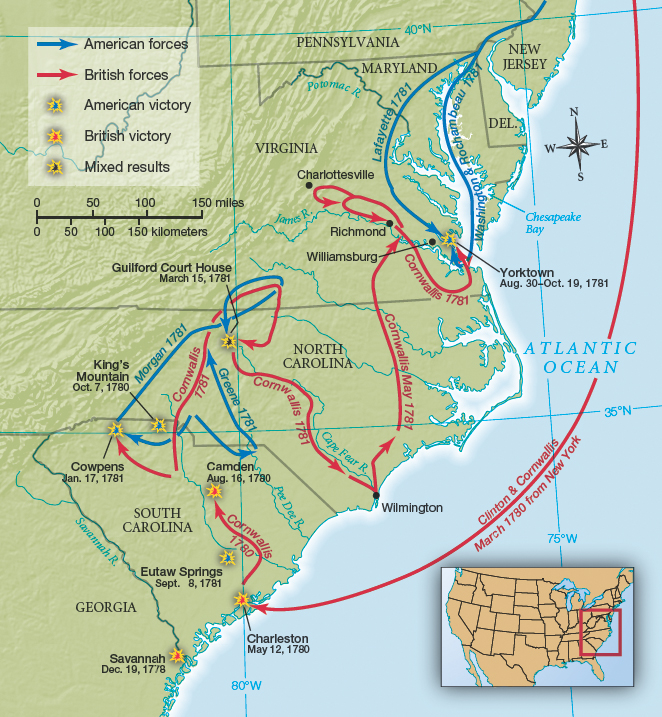Georgia and South Carolina.
Printed Page 181 Chapter Chronology
Georgia and South Carolina. The new strategy called for British forces to abandon New England and focus on the South, with its valuable crops and its large slave population, a destabilizing factor that might keep rebellious white southerners in line. Georgia and the Carolinas appeared to hold large numbers of loyalists, providing a base for the British to recapture the southern colonies one by one, before moving north to the more problematic middle colonies and New England.

Georgia, the first target, fell at the end of December 1778 (Map 7.4). A small army of British soldiers occupied Savannah and Augusta, and a new royal governor and loyalist assembly were quickly installed. The British quickly organized twenty loyal militia units, and 1,400 Georgians swore an oath of allegiance to the king. So far, the southern strategy looked as if it might work.
Next came South Carolina. The Continental army put ten regiments into the port city of Charleston to defend it from attack by British troops shipped south from New York under the command of General Clinton, Howe's replacement as commander in chief. For five weeks in early 1780, the British laid siege to the city and took it in May 1780, capturing 3,300 American soldiers.
Clinton next announced that slaves owned by rebel masters were welcome to seek refuge with his army, and several thousand escaped to the coastal city. Untrained in formal warfare, they were of use to the British as knowledgeable guides to the countryside and as laborers building defensive fortifications. Escaped slaves with boat-piloting skills were particularly valuable for crucial aid in navigating the inland rivers of the southern colonies.
Clinton returned to New York, leaving the task of pacifying the rest of South Carolina to General Charles Cornwallis and 4,000 troops. A bold commander, Lord Cornwallis quickly chased out the remaining Continentals and established military rule of South Carolina by midsummer. He purged rebels from government office and disarmed rebel militias. Exports of rice, South Carolina's main crop, resumed, and pardons were offered to Carolinians willing to prove their loyalty by taking up arms for the British.
By August, American troops arrived from the North to strike back at Cornwallis. General Gates, the hero of Saratoga, led 3,000 troops, many of them newly recruited militiamen, into battle against Cornwallis at Camden, South Carolina, on August 16 (see Map 7.4). The militiamen panicked at the sight of the approaching British cavalry, however, and fled. When regiment leaders tried to regroup the next day, only 700 soldiers showed up. The battle of Camden was a devastating defeat, the worst of the entire war, and prospects seemed very grim for the Americans.